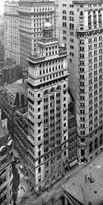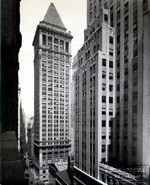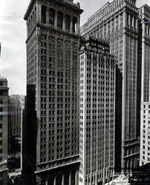THE BANKERS TRUST COLLECTION





Demolishing the Gillender Building in 1910





Constructing the original Bankers Trust Building in 1911





Demolishing the Hanover National Bank in 1931





Constructing the Bankers Trust Annex in 1931-33
Contained on the following pages are over 200 vintage construction progress photographs, representing a collection of 213 owned by The Skyscraper Museumand 27 owned by structural engineers Weiskopf and Pickworth LLP, of 14-16 Wall Street,also known as the Bankers Trust Building. This database has been made possible by generous funding from the Graham Foundation for Advanced Studies in the Fine Arts.
The office tower, located at the northwest corner of Wall, Nassau and Broad Streets - the most famous intersection in business history - is the product of a long cycle of construction and reconstruction that tells a story about the intersection of the architectural, engineering, business and real estate forces that have shaped New York City.
Long occupied by commercial uses, the value of the lot at the corner of Wall and Nassau Streets rose more than tenfold by 1896 when the owners decided to replace a 6-story structure, the Union Building, with a 300-foot tall tower. The slender Gillender Building - then fourth tallest in the city - rose 22 stories on a site of only 26 x 73 feet.
View a map of 1899.
Twelve years later the building and lot were sold to the Manhattan Trust Company for the highest price ever recorded in Manhattan: over $800 a square foot, according to the New York Times. The same year, the Bankers Trust Company, which absorbed the Manhattan Trust, negotiated a lease on the adjoining L-shaped lot, home to the 7-story Stevens Building. The company decided to replace the Gillender - then the tallest building ever razed - and the Stevens with a much larger structure on a combined lot of 93 x 96 feet. At 41-stories, the new building was the tallest banking building in the world when it opened in 1912.
View a map of 1912.
Fewer than 20 years later, the Bankers Trust Company expanded yet again by acquiring three additional neighbors: the 8-story Astor Building at 10 Wall Street and 9 Pine Street, the 10-story 7 Pine Street, and the turn-of-the-century Hanover National Bank. Rather than start from scratch again, the company opted to construct an annex to the original tower, designed by Shreve, Lamb and Harmon, architects of the Empire State Building. This L-shaped Art Deco annex more than tripled the building's rentable area.
View a map showing the current configuration of buildings at this site.
Today the exterior
of the Bankers Trust Building remains unchanged and, as a protected landmark,
will do so in perpetuity.
Introduction by Matt Lasner and Carol Willis. Photograph captions by structural engineer Derek Trelstad.
| April 12, 1910 |

Gillender Building (1897)
August 10, 1931
|

Bankers Trust Tower (1912)
March 16, 1932
|

Bankers Trust Addition (1933)
This collection of photographs was donated to The Skyscraper Museum by the Bankers Trust Foundation. It is organized chronologically, in the order recorded on the images by the photographer. Images can also be viewed by category (see menu).
The chronological section collects the archive into two sets. The first set of photographs date from 1910-1911 and record the demolition of the Gillender and Stevens Buildings and the progress of the new Bankers Trust Building.
The second set of photographs date from 1931-1933 and document the removal of the old Astor Building, 9 Pine Street and the Hanover National Bank, and the construction of the annex.
Photographs are the property of The Skyscraper Museum unless otherwise noted. Click on the images in the database for larger versions and detailed descriptions.